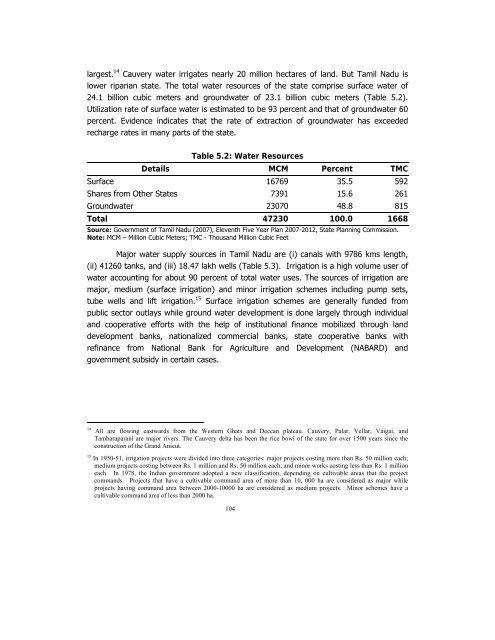POVERTY REDUCTION STRATEGY TN
You also want an ePaper? Increase the reach of your titles
YUMPU automatically turns print PDFs into web optimized ePapers that Google loves.
largest. 14 Cauvery water irrigates nearly 20 million hectares of land. But Tamil Nadu is<br />
lower riparian state. The total water resources of the state comprise surface water of<br />
24.1 billion cubic meters and groundwater of 23.1 billion cubic meters (Table 5.2).<br />
Utilization rate of surface water is estimated to be 93 percent and that of groundwater 60<br />
percent. Evidence indicates that the rate of extraction of groundwater has exceeded<br />
recharge rates in many parts of the state.<br />
Table 5.2: Water Resources<br />
Details MCM Percent TMC<br />
Surface 16769 35.5 592<br />
Shares from Other States 7391 15.6 261<br />
Groundwater 23070 48.8 815<br />
Total 47230 100.0 1668<br />
Source: Government of Tamil Nadu (2007), Eleventh Five Year Plan 2007-2012, State Planning Commission.<br />
Note: MCM – Million Cubic Meters; TMC - Thousand Million Cubic Feet<br />
Major water supply sources in Tamil Nadu are (i) canals with 9786 kms length,<br />
(ii) 41260 tanks, and (iii) 18.47 lakh wells (Table 5.3). Irrigation is a high volume user of<br />
water accounting for about 90 percent of total water uses. The sources of irrigation are<br />
major, medium (surface irrigation) and minor irrigation schemes including pump sets,<br />
tube wells and lift irrigation. 15 Surface irrigation schemes are generally funded from<br />
public sector outlays while ground water development is done largely through individual<br />
and cooperative efforts with the help of institutional finance mobilized through land<br />
development banks, nationalized commercial banks, state cooperative banks with<br />
refinance from National Bank for Agriculture and Development (NABARD) and<br />
government subsidy in certain cases.<br />
14<br />
All are flowing eastwards from the Western Ghats and Deccan plateau. Cauvery, Palar, Vellar, Vaigai, and<br />
Tambaraparani are major rivers. The Cauvery delta has been the rice bowl of the state for over 1500 years since the<br />
construction of the Grand Anicut.<br />
15 In 1950-51, irrigation projects were divided into three categories: major projects costing more than Rs. 50 million each;<br />
medium projects costing between Rs. 1 million and Rs. 50 million each; and minor works costing less than Rs. 1 million<br />
each. In 1978, the Indian government adopted a new classification, depending on cultivable areas that the project<br />
commands. Projects that have a cultivable command area of more than 10, 000 ha are considered as major while<br />
projects having command area between 2000-10000 ha are considered as medium projects. Minor schemes have a<br />
cultivable command area of less than 2000 ha.<br />
104

















